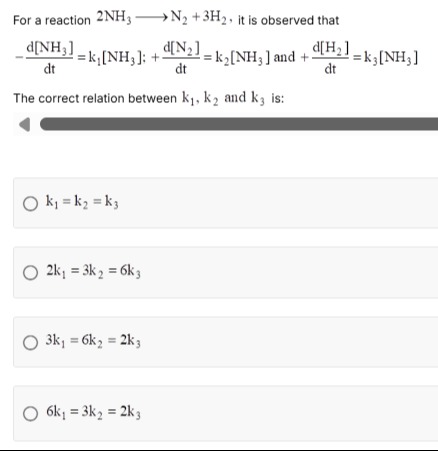Question
Question: For a reaction $2NH_3 \longrightarrow N_2 + 3H_2$, it is observed that $-\frac{d[NH_3]}{dt} = k_1[NH...
For a reaction 2NH3⟶N2+3H2, it is observed that −dtd[NH3]=k1[NH3]; +dtd[N2]=k2[NH3] and +dtd[H2]=k3[NH3]
The correct relation between k1, k2 and k3 is:

A
k_1 = k_2 = k_3
B
2k_1 = 3k_2 = 6k_3
C
3k_1 = 6k_2 = 2k_3
D
6k_1 = 3k_2 = 2k_3
Answer
3k_1 = 6k_2 = 2k_3
Explanation
Solution
The reaction is 2NH3⟶N2+3H2. The rate of the reaction can be expressed in terms of the rate of change of concentration of each species, divided by its stoichiometric coefficient.
Rate =−21dtd[NH3]=+dtd[N2]=+31dtd[H2].
We are given:
−dtd[NH3]=k1[NH3]
+dtd[N2]=k2[NH3]
+dtd[H2]=k3[NH3]
Substitute:
Rate =21k1[NH3]=k2[NH3]=31k3[NH3].
Therefore, 21k1=k2=31k3.
Multiply by 6: 3k1=6k2=2k3.
